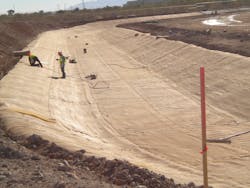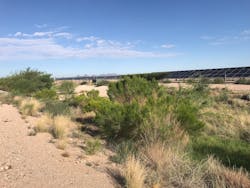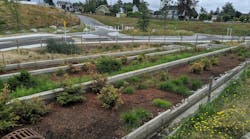The University of Arizona (UA) in Tucson is a world leader in solar energy research and its Solar Zone at Tech Park is one of the largest multi-technology solar demonstration sites in the US. The site resides on a 200-acre plot that includes a state-of-the-art 5 megawatt (MW) solar plant with 95,000 solar panels and more than 100 solar concentrators that generate power. For a decade, this facility has served as a collaborative hub for researchers and industry to study and harness the power of solar energy and bring it to market.
During the construction of the Solar Zone in 2010, a central drainage channel was incorporated into the project design to facilitate stormwater runoff from the solar panels and upgradient offsite drainage areas. The beginning of the channel was lined with concrete to collect concentrated flow from the up-gradient drainage and adjacent floodplain areas. The budget was a major concern for this project. Therefore, in lieu of lining the remainder of the channel with concrete, rock riprap, articulated concrete blocks or other hard armoring techniques, design engineer John Wallace, PE, CFM, JE Fuller/Hydrology & Geomorphology, determined a flexible channel liner would be more cost-effective.
“Flexible lining for major drainage through the project site allowed considerable cost savings over traditional hardscape materials, such as gunite, riprap, or wire-tied rock,” says Wallace. In addition to cost savings, these types of systems also meet hydraulic, durability, and erosion performance requirements.
Commonly, performance criteria for channel stabilization materials have focused on hydraulic parameters such as shear stress and flow velocity. However, for alternative flexible channel liners, field performance is also highly dependent on non-hydraulic factors such as ultraviolet (UV) resistance, tensile strength, and maintenance. One of the main performance requirements for selecting the alternative flexible channel liner for this project was long-term design life and durability. UA Tech Park is located in Tucson, where summer temperatures commonly top 100°F, vegetation is limited, and UV exposure is intense. Wallace wanted an alternative flexible channel lining that was not only cost-effective but could stand up to these harsh arid conditions and provide resilient erosion protection during flood events.
Several alternative flexible channel liner systems were considered, however, PYRAMAT 75, a High Performance Turf Reinforcement Mat (HPTRM) manufactured by Propex, was chosen to meet the design and performance requirements. PYRAMAT 75 is a three-dimensional, lofty, woven polypropylene geotextile designed with patented X3 Fiber Technology for erosion control on slopes and drainage channels. Wallace selected PYRAMAT 75 because it’s engineered to provide erosion control and slope protection for up to 75 years in an unvegetated environment, which is nearly three times longer than alternative systems that were considered for this project. Site conditions meant three key characteristics—UV resistance, high tensile strength, and hydraulic performance in a sparsely vegetated environment—would be needed to support the long-term durability of the system.
UV Resistance
UV resistance is a crucial performance property for HPTRMs in channel applications. Whether the channel or slope is vegetated or unvegetated, UV degradation is one of the most common failure mechanisms of permanent vegetated armoring systems, often lead by insufficient UV resistance and tensile strength (Koerner et al. 2005, Li and Khanna 2008). UV resistance is reported as a percent of tensile strength retained of an HPTRM after a certain period of accelerated UV exposure when compared to the original tensile strength of the HPTRM. Per ASTM D-4355, PYRAMAT 75 HPTRM has 90% retention at 3,000 hours and 6,000 hours. This is six times greater than the UV protection provided by conventional turf reinforcement mats, making it an excellent choice for arid environments.
Field performance is also critical with respect to design life confidence. Field samples should be evaluated in order to correlate results from ASTM D-4355 to real-world exposure for a better understanding of the material design life. In 2015, samples of PYRAMAT 75 were taken from the Bell Road Channel project in Scottsdale, AZ, to determine the retained tensile strength after 13 years of exposure. With minimal vegetation established, the majority of the HPTRM was exposed in a severe environment with some of the highest solar radiation in the continental United States, at 21.70 megajoules per square meter per day. The results showed an average retained tensile strength of 80% when compared to independent third-party test results.
Tensile Strength
Tensile strength is the primary property that determines the initial and long-term performance of the HPTRM, especially when non-hydraulic stresses are encountered. Non-hydraulic stresses can consist of loads from vehicular traffic during installation and maintenance, debris loading, mowing, and animal loading. When the tensile strength is not adequate to account for all of these non-hydraulic stresses incurred during the life of the project, material failure can occur. These types of failures can include ripping or tearing of the lining, and lessening—if not eliminating—the improved hydraulic performance provided by the HPTRM. For this installation, tensile strength was also important because it allowed for a better connection to the hardscape sections of the channel. “Design flows for the channel ranged from 302 cubic feet per second at the east end to 634 at the west end,” says Wallace. PYRAMAT 75 provides 4,000 pounds per foot of tensile strength to meet the durability, longevity, and hydraulic design to ensure long-term performance.
Vegetation
Another important function of the PYRAMAT 75 is its ability to protect against erosion in both vegetated and unvegetated environments. Vegetation is one factor that can greatly influence the hydraulic and erosion performance of an HPTRM and provides for improved water quality. Colorado State University’s (CSU) Hydraulics Laboratory has been testing HPTRMs both vegetated and unvegetated for twenty years. CSU researchers have found that, when used to reinforce vegetation, HPTRMs can greatly increase the hydraulic performance limits of natural vegetation by reinforcing root structures and providing added stability throughout the design life of the project. Their research has also demonstrated that HPTRMs can still provide erosion protection in unvegetated or sparsely vegetated arid environments. PYRAMAT 75’s trilobal X3 Fiber Technology helps lock in moisture and promote rapid root mass development—this ability to successfully and quickly vegetate, even in arid environments, was another reason it was selected for the Solar Park project.
Concrete channel lining and articulated concrete block were alternatives considered by Wallace. In addition to being more expensive and more difficult to install and maintain, concrete provides a harsh look that sharply contrast with the natural environment. The UA Solar Park is an international leader in green energy research, and it was important that its facility maintain a natural look. After installation, the PYRAMAT 75 lined channel has achieved 20 to 30% vegetation density in most areas and in some locations achieved more than 50% vegetation density, even the in harsh desert arid conditions.
In addition to promoting vegetation and improving water quality, PYRAMAT 75 HPTRM is an environmentally friendly armoring method. From cradle to grave, its carbon footprint is 2.7 kilograms of carbon dioxide equivalent (CO2e) per square meter of material. CO2e is a way to describe different greenhouse gasses as a common unit. For any quantity and type of greenhouse gas, CO2e expresses the amount of carbon dioxide that would have the equivalent global warming impact. Comparatively, the carbon footprint of concrete-based alternatives are up to 10 times higher.
The environmental benefits of PYRAMAT 75 HPTRM extend into the product’s useful life. Once installed, PYRAMAT 75 HPTRM helps to decrease sedimentation and pollutants and encourages the infiltration of water back into the groundwater table. These are two reasons why the EPA has identified systems that utilize HPTRMs as a Best Management Practice (BMP) for improving water quality.
A final deciding factor for Wallace was his previous experience with the product. He had used PYRAMAT 75 HPTRM before and says, “it offered a cost-effective, high-performance solution.” Approximately 41,500 square yards of PYRAMAT 75 were installed along the channel.
Present Day
In any environment, especially one as harsh as the one at UA’s Solar Park, specs and anticipated performance is one thing, but long-term results are another—how well a solution actually holds up and continues to perform is key. The PYRAMAT 75 HPTRM has been installed at this site for more than a decade. Propex and the design manager continue to monitor the performance, but the installation has retained its strength and held up against the harsh and arid Tuscon climate and several flood events. The channel is well vegetated for the arid environment and has protected the UA Tech Park solar field by conveying drainage though the site in a non-erosive manner.
References
Koerner, R. M., G. R. Koerner, and Y. G. Hsuan. 2005. “Lifetime prediction of exposed geo-membranes.” Erosion of soils and scour of foundations. Reston, VA: Geotechnical Special Publication 135, ASCE Geo-frontiers. 2005.
Li, M.-H., and S. Khanna. 2008. “Aging of rolled erosion control products for channel erosion control.” Geosynthetics International 15, no. 4 (2018): 224–231. www.icevirtuallibrary.com/doi/abs/10.1680/gein.2008.15.4.224
About the Author
Kathryn Grant
Kathryn Grant is the marketing manager for Propex GeoSolutions. She holds a Bachelor of Journalism from the University of TN, Knoxville, and an Executive Master of Business from the University of TN, Chattanooga.




